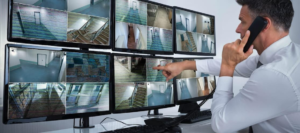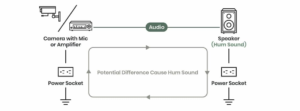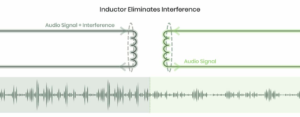
Ground loops can cause video/audio hums and interference. With this tutorial, you might not necessarily need a ground loop isolator to fix the irritating ground loop noise. We will show you how to fix the noise by inspecting the devices, rearranging your set-up, or using a ground loop isolator to eliminate interference.
What Causes a Ground Loop? What is a Ground Loop?

In an ideal electrical system, the ground potentials between the devices are zero. However, electronic devices always have different potentials as the connections get complicated. When enough current is flowing in the connection between two ground points that have different resistances, the ground loop is formed. Therefore, the noise will be produced and carried along with the signal transmitted to the receiver devices.
Types of Grounding
Grounding plays a crucial role in electricity, so we need to figure out that before solving the problem. The ground is a reference point in an electrical circuit and is used as a reference point for voltage measurements. Generally, there’re 3 types of grounds: earth ground, signal ground, and chassis ground.

Earth Ground
It refers to the physical connection between an electrical body and the earth (typically using a metal rod fixed under the earth). When an electrical device connects to artificial or natural ground, the connection provides the path for extraneous and unwanted current to circulate through the circuit and add interference to the video/ audio signal.
Signal Ground
Signal ground is the ground transmitted along with an analog or digital signal between electrical devices in a system. Since the devices are powered separately, they’re more likely to have ground potential differences and thus produce currents to interfere. Moreover, when there’re multiple paths for electricity to flow to the ground, the ground paths will carry interference currents and turn them into voltage fluctuations. This will make the ground reference in the system no longer a stable potential, and eventually, noise becomes a part of the signal.
Chassis Ground
A chassis ground is a point that connects to the metal enclosure of an electrical device. Its use may vary by electronics manufacturers, but it’s typically used for shielding and grounding. By connecting the chassis with earth ground at one point, currents will be prevented from circulating through the chassis. Otherwise, the current can flow through the chassis and cause unwanted results like ground loops.
Diagnose Audio/Video Interference
There’re many reasons to cause interference. But how can we identify it is caused by ground loops? Fortunately, we can tell if it’s ground loop interference by some traits, so let’s look into it!
Ground Loop Audio Noise
When interference happens in an audio system, you can hear a buzz or hum sound in the background. It’s annoying when it happens while listening to your favorite songs and it may sound weirdly unsatisfying when listening to it alone, right?
Ground Loop Video Interference
In a video system, ground loops may distort picture rolling, and horizontal bars or syncing problems, which is also a common CCTV camera interference. The result may differ by how bad the interference is.

Troubleshoot—Eliminate Ground Loops
When ground loops happen in different scenarios, the solutions can be different too. Following are 4 ways to respond to different applications.
Solution #1: Have the Same Ground Reference Potential
We often see ground loop interference happen when electrical devices use different power sockets that have distinct resistances. To improve it, we recommend all A/V devices connect at the same ground point to avoid potential differences. This method is effective but too ideal to implement in some A/V systems due to complicated wiring.
Solution #2: Separate from Metal Conductors
When AV equipment directly contacts with a metal conductor that acts as a ground point, the likelihood of getting interfered with will be greatly increased. In this case, it’s recommended to place a wooden or plastic object between the equipment and the conductor to isolate the ground loop.
Solution #3: Check All Connected Devices
Devices that interconnect in a system can make interferences as well. Try to remove the connections between all devices and replug them respectively to find the problem. Or you can bring all equipment to another space (like a building, house). By doing so, you can check whether the interference is on the equipment. If the interference remains, try to consult an electrician to ensure that your system is properly grounded.
Solution #4: Use a Ground Loop Noise Isolator
Sometimes, it’s hard to identify what causes the ground loop, due to complicated cabling and connection. If this is the case, using a ground loop isolator can be a quick solution to the issue. It can effectively isolate the current from circulating through the circuit by cutting the loop path. It’s quick, but also causes small signal loss that might compromise a little video/audio quality.
Warning: Remove the Ground
Removing the grounding of equipment is a misunderstanding and dangerous way to solve the issue. The main purpose of grounding is to lead the extraneous currents to the ground, avoiding surges and current leakage. If equipment is not properly grounded, the currents could flow from the conductive parts to the ground via a conductive path which can be a human body.

How Does a Ground Loop Isolator Work?
A ground loop isolator typically uses an inductor that stores energy in a magnetic field when electric current flows through it. When the current flowing through the inductor changes, the inductor opposes any changes in current through them. Therefore, the current won’t fluctuate and not lead to potential differences.

Other Causes of Ground Loops
If you’ve tried everything mentioned above, maybe, the problem is not ground loops. Installation and cables can also be a major cause. Here are two things you can put your effort into.
Improper Connections

Most of the time, signals are transmitted from one device to another via physical connections. If there is a problem with the connection, the audio and video can be also compromised. Therefore, we recommend that you check whether the cable is damaged, the connector is loose, or not matched.
Causes of Electrical Interference

Generally, a professional A/V system has a lot of cables laying together. Because of the short distance between cables, such as power lines, telephone wires, and audio/ video cables, they have a higher chance of interfering with one another. In this situation, we recommend keeping at least 30cm between cables to avoid interference.
Need More Help from Engineering Specialists and Pro AV Manufacturer?
We have been in the professional A/V and CCTV industries for 20 years. From our experience, there is no one particular way that applies to all situations. Audio/Video noise may result from various kinds of problems. If you’ve tried all the methods mentioned above but cannot troubleshoot, don’t hesitate to contact professionals who can provide effective solutions to different situations. You’re also welcome to drop us a message if there’s anything we can help with!
